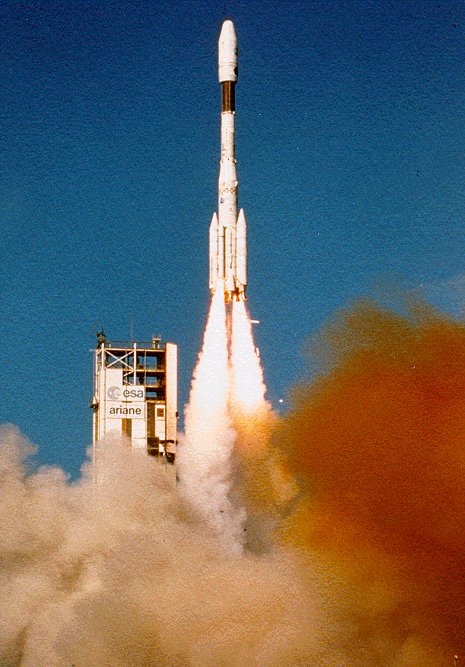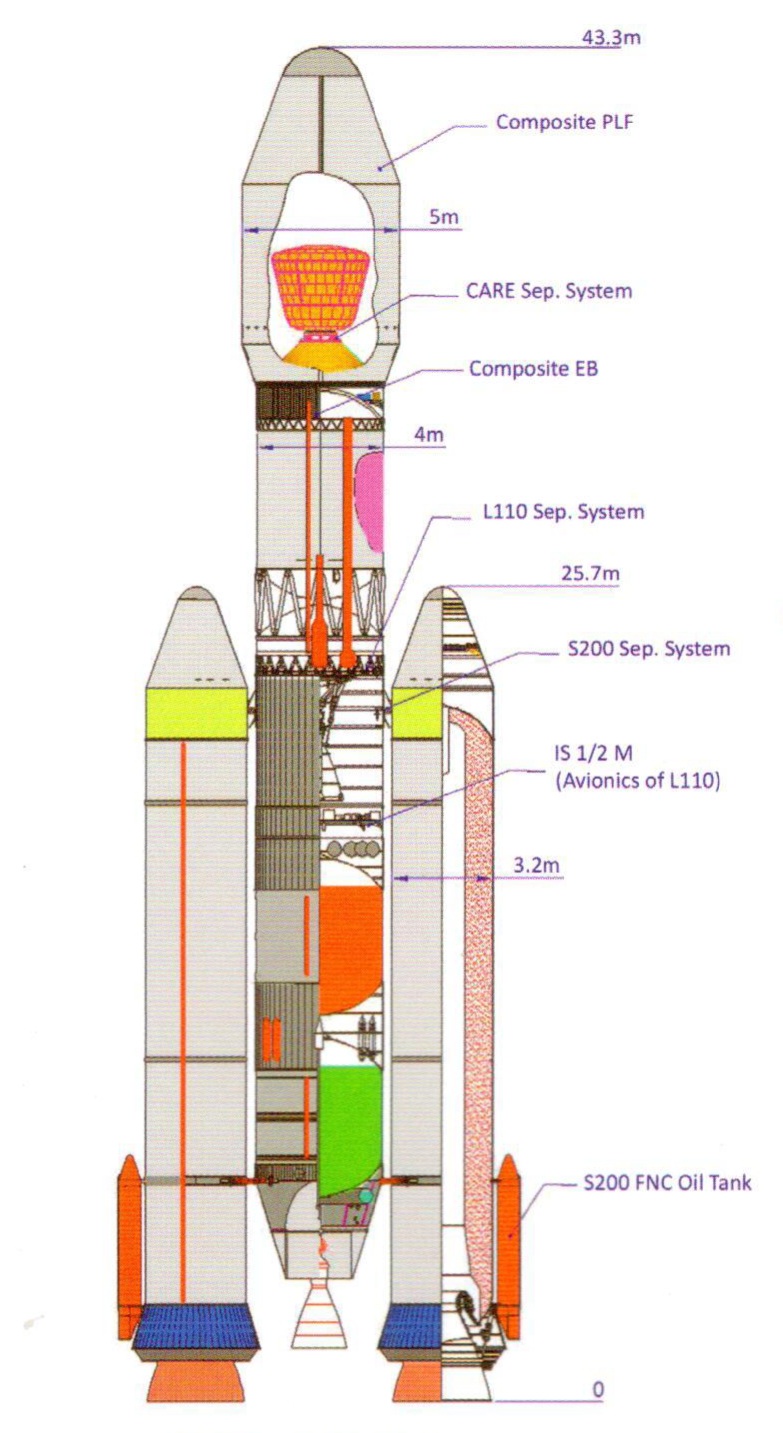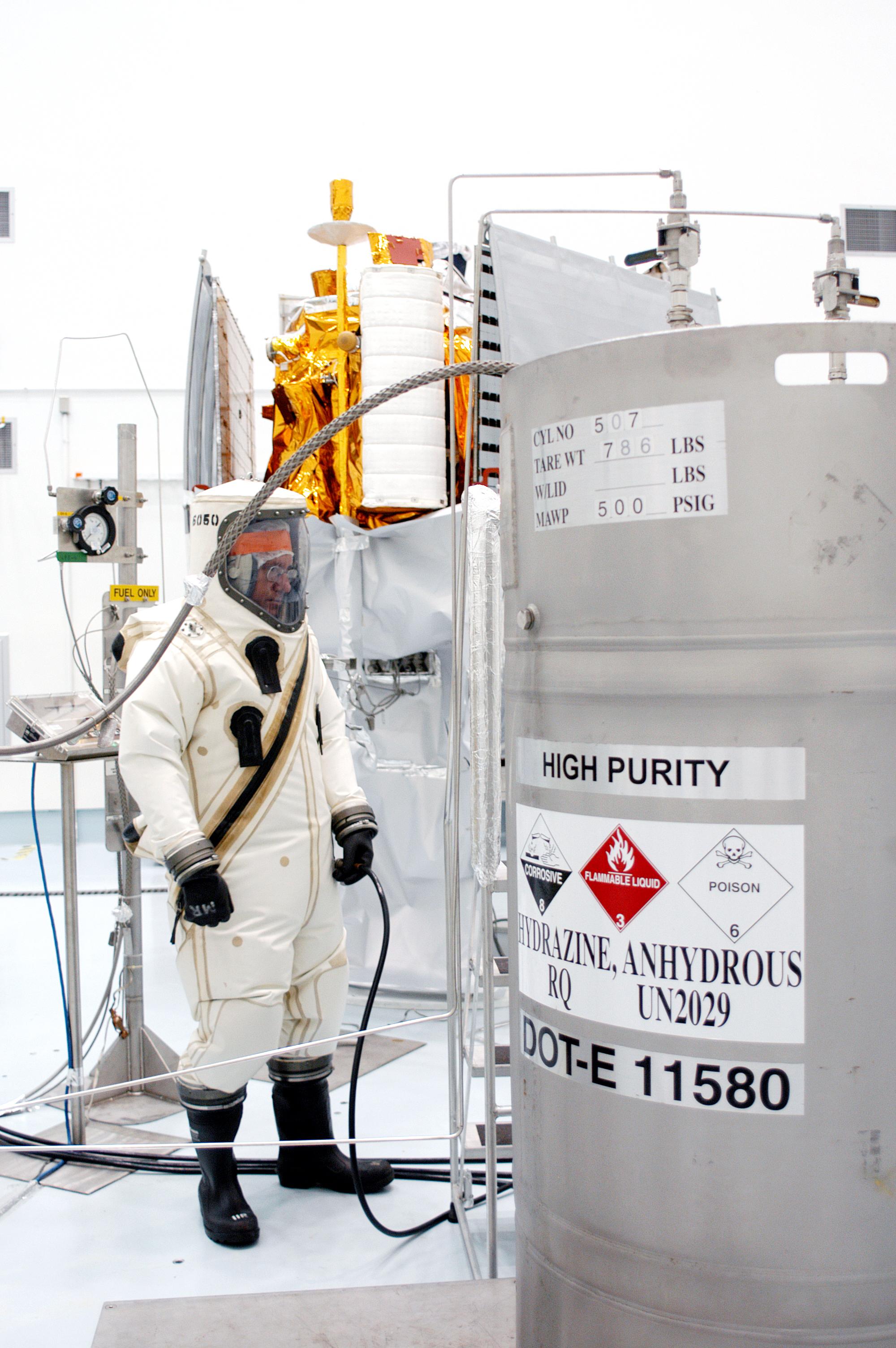|
UH 25
UH 25 is a fuel mixture for rockets. It was developed for the European Ariane 2–4 launch vehicles. UH 25 was developed after a disaster during flight 2 of the Ariane 1 rocket. During launch, one of the four Viking engines on the first stage developed a combustion instability which led to an engine fire, subsequent explosion and destruction of the vehicle. Following this event and starting with Ariane 2, the fuel was changed from pure UDMH to the mixture UH 25. UH 25 was used in Ariane rocket versions 2 through 4, and in the Indian GSLV Mk III. UH 25 is a mixture of 75% UDMH and 25% hydrazine hydrate.Tim Furniss: ''Ingenieure bei der Arbeit, Raumschiffe und Raketen'', Tessloff Verlag, Nürnberg (1989), Seite: 31 (German) It is hypergolic with dinitrogen tetroxide as oxidizer, and both can be stored as liquids at room temperature. Danger Like its components, UH 25 is flammable, toxic (carcinogenic) and corrosive. Safety labels See also * Aerozine 50 - a 50:50 mix of hydraz ... [...More Info...] [...Related Items...] OR: [Wikipedia] [Google] [Baidu] |
Ariane (rocket)
Ariane is a series of European civilian expendable launch vehicles for space launch use. The name comes from the French spelling of the mythological character Ariadne. France first proposed the Ariane project and it was officially agreed upon at the end of 1973 after discussions between France, Germany and the UK. The project was Western Europe's second attempt at developing its own launcher following the unsuccessful Europa project. The Ariane project was code-named L3S (the French abbreviation for third-generation substitution launcher). The European Space Agency (ESA) charged Aérospatiale (whose former assets now form Airbus) with the development of all Ariane launchers and of the testing facilities, while Arianespace handled production, operations and marketing after its creation in 1980. Arianespace launches Ariane rockets from the Guiana Space Centre at Kourou in French Guiana. As a result of the merger in 2000 that founded Airbus, the new corporation's space branch and su ... [...More Info...] [...Related Items...] OR: [Wikipedia] [Google] [Baidu] |
Ariane 1
Ariane 1 () was the first rocket in the Ariane family of expendable launch systems. It was developed for and operated by the European Space Agency (ESA), which had been formed in 1973, the same year that development of the launcher had commenced. Aérospatiale was designated to lead the programme. Ariane 1 was the first launcher to be developed with the primary purpose of sending commercial satellites into geosynchronous orbit. Crucially, it was designed with the ability of sending a pair of satellites into orbit on a single launcher, thus reducing costs. As the size of satellites grew, Ariane 1 quickly gave way to the more powerful Ariane 2 and Ariane 3 launchers, which were heavily based upon the original rocket. The Ariane 4 was the last rocket to heavily draw upon the Ariane 1, as the successor rocket Ariane 5 uses a far greater proportion of all-new elements. Development Origins In 1975, ten European countries decided to pursue joint collaboration in the field of sp ... [...More Info...] [...Related Items...] OR: [Wikipedia] [Google] [Baidu] |
Viking (rocket Engine)
The Viking rocket engines were members of a series of bipropellant engines for the first and second stages of the Ariane 1 through Ariane 4 commercial launch vehicles, using storable, hypergolic propellants: dinitrogen tetroxide and UH 25, a mixture of 75% UDMH and 25% hydrazine (originally UDMH). The earliest versions, developed in 1965, had a sea-level thrust of about 190 kN. By 1971, the thrust had improved to 540 kN, with resulting engine named Viking 1 and adopted for the Ariane program. The engine first flown on the Ariane 1 rocket in 1979 was Viking 2, with thrust further improved to 611 kN. The version used on the Ariane 4 first stage, which used a cluster of four, had 667 kN thrust each. The second stage of Ariane used a single Viking. Over 1000 were built, and achieved a high level of reliability from early in the programme. The 144 Ariane 1 to 4 launchers used a total of 958 Viking engines. Only two engines led to a failure. The first failure (on ... [...More Info...] [...Related Items...] OR: [Wikipedia] [Google] [Baidu] |
Ariane 2
Ariane 2 was a European expendable space launch vehicle, operated by the European Space Agency (ESA) between 1986 and 1989 as part of Ariane family of rockets. The principal manufacturer for the Ariane 2 was Aérospatiale, while the lead agency for its development was the '' Centre National d'Etudes Spatiales'' (CNES), the French government's space agency.Harvey 2003, p. 515. Development of the Ariane 2 was authorised in July 1979, months prior to the Ariane 1's first flight. Drawing heavily upon both the design and infrastructure of the Ariane 1, the new launcher was concurrently developed alongside the Ariane 3, with which it shared much of its design. It represented an advancement of the Ariane 1 rather than a replacement, but was capable of lifting even heavier payloads into Geostationary transfer orbit (GTO). Developed largely within a two-year window, the Ariane 2 performed its maiden flight on 31 May 1986, actually flying after its Ariane 3 sibling. During its brief se ... [...More Info...] [...Related Items...] OR: [Wikipedia] [Google] [Baidu] |
Geosynchronous Satellite Launch Vehicle Mk III
The Launch Vehicle Mark-3 or LVM3 (previously referred as the Geosynchronous Satellite Launch Vehicle Mark III or GSLV Mk III) is a three-stage medium-lift launch vehicle developed by the Indian Space Research Organisation (ISRO). Primarily designed to launch communication satellites into geostationary orbit, it is also due to launch crewed missions under the Indian Human Spaceflight Programme. LVM3 has a higher payload capacity than its predecessor, GSLV. After several delays and a sub-orbital test flight on 18 December 2014, ISRO successfully conducted the first orbital test launch of LVM3 on 5 June 2017 from the Satish Dhawan Space Centre. Total development cost of project was . In June 2018, the Union Cabinet approved to build 10 LVM3 rockets over a five-year period. The LVM3 has launched CARE, India's space capsule recovery experiment module, Chandrayaan-2 and Chandrayaan-3, India's second and third lunar missions, and will be used to carry Gaganyaan, the first crewed ... [...More Info...] [...Related Items...] OR: [Wikipedia] [Google] [Baidu] |
UDMH
Unsymmetrical dimethylhydrazine (abbreviated as UDMH; also known as 1,1-dimethylhydrazine, heptyl or Geptil) is a chemical compound with the formula H2NN(CH3)2 that is primarily used as a rocket propellant. At room temperature, UDMH is a colorless liquid, with a sharp, fishy, ammonia-like smell typical of organic amines. Samples turn yellowish on exposure to air and absorb oxygen and carbon dioxide. It is miscible with water, ethanol, and kerosene. At concentrations between 2.5% and 95% in air, its vapors are flammable. It is not sensitive to shock. Symmetrical dimethylhydrazine (1,2-dimethylhydrazine) also exists, but it is not as useful. UDMH can be oxidized in air to form many different substances, including toxic ones. Synthesis In 1875, UDMH was first prepared by Emil Fischer, who discovered and named the class of hydrazines, by reducing N-Nitrosodimethylamine with zinc in boiling acetic acid. Fischer's student Edward Renouf later studied UDMH more extensively as part ... [...More Info...] [...Related Items...] OR: [Wikipedia] [Google] [Baidu] |
Hydrazine Hydrate
Hydrazine is an inorganic compound with the chemical formula . It is a simple pnictogen hydride, and is a colourless flammable liquid with an ammonia-like odour. Hydrazine is highly hazardous unless handled in solution as, for example, hydrazine hydrate (). Hydrazine is mainly used as a foaming agent in preparing polymer foams, but applications also include its uses as a precursor to pharmaceuticals and agrochemicals, as well as a long-term storable propellant for in-space spacecraft propulsion. Additionally, hydrazine is used in various rocket fuels and to prepare the gas precursors used in airbags. Hydrazine is used within both nuclear and conventional electrical power plant steam cycles as an oxygen scavenger to control concentrations of dissolved oxygen in an effort to reduce corrosion. , approximately 120,000 tons of hydrazine hydrate (corresponding to a 64% solution of hydrazine in water by weight) were manufactured worldwide per year. Hydrazines are a class of organ ... [...More Info...] [...Related Items...] OR: [Wikipedia] [Google] [Baidu] |
Hypergolic
A hypergolic propellant is a rocket propellant combination used in a rocket engine, whose components spontaneously ignite when they come into contact with each other. The two propellant components usually consist of a fuel and an oxidizer. The main advantages of hypergolic propellants are that they can be stored as liquids at room temperature and that engines which are powered by them are easy to ignite reliably and repeatedly. Common hypergolic propellants are extremely toxic or corrosive, making them difficult to handle. In contemporary usage, the terms "hypergol" and "hypergolic propellant" usually mean the most common such propellant combination: dinitrogen tetroxide plus hydrazine. History The fact that turpentine may spontaneously combust when mixed with nitric acid was discovered as early as the late 17th century by Frederick Slare, but it remained a scientific curiosity for centuries until it was proposed to use it for rocket-assisted take off during WWII. In 1935, ... [...More Info...] [...Related Items...] OR: [Wikipedia] [Google] [Baidu] |
Dinitrogen Tetroxide
Dinitrogen tetroxide, commonly referred to as nitrogen tetroxide (NTO), and occasionally (usually among ex-USSR/Russian rocket engineers) as amyl, is the chemical compound N2O4. It is a useful reagent in chemical synthesis. It forms an equilibrium mixture with nitrogen dioxide. Its molar mass is 92.011 g/mol. Dinitrogen tetroxide is a powerful oxidizer that is hypergolic (spontaneously reacts) upon contact with various forms of hydrazine, which has made the pair a common bipropellant for rockets. Structure and properties Dinitrogen tetroxide could be regarded as two nitro groups (-NO2) bonded together. It forms an equilibrium mixture with nitrogen dioxide. The molecule is planar with an N-N bond distance of 1.78Å and N-O distances of 1.19Å. The N-N distance corresponds to a weak bond, since it is significantly longer than the average N-N single bond length of 1.45Å. This exceptionally weak σ bond (amounting to overlapping of the ''sp''2 hybrid orbitals of the two NO2 uni ... [...More Info...] [...Related Items...] OR: [Wikipedia] [Google] [Baidu] |
Hazard T
A hazard is a potential source of harm. Substances, events, or circumstances can constitute hazards when their nature would potentially allow them to cause damage to health, life, property, or any other interest of value. The probability of that harm being realized in a specific ''incident'', combined with the magnitude of potential harm, make up its risk. This term is often used synonymously in colloquial speech. Hazards can be classified in several ways which are not mutually exclusive. They can be classified by ''causing actor'' (for example, natural or anthropogenic), by ''physical nature'' (e.g. biological or chemical) or by ''type of damage'' (e.g., health hazard or environmental hazard). Examples of natural disasters with highly harmful impacts on a society are floods, droughts, earthquakes, tropical cyclones, lightning strikes, volcanic activity and wildfires. Technological and anthropogenic hazards include, for example, structural collapses, transport accidents, accident ... [...More Info...] [...Related Items...] OR: [Wikipedia] [Google] [Baidu] |
Aerozine 50
__NOTOC__ Aerozine 50 is a 50:50 mix by weight of hydrazine and unsymmetrical dimethylhydrazine (UDMH), developed in the late 1950s by Aerojet General Corporation as a storable, high-energy, hypergolic fuel for the Titan II ICBM rocket engines. Aerozine continues in wide use as a rocket fuel, typically with dinitrogen tetroxide () as the oxidizer, with which it is hypergolic. Aerozine 50 is more stable than hydrazine alone, and has a higher density and boiling point than UDMH alone. Pure hydrazine has a higher performance than Aerozine 50, but an inconvenient freezing point of 2 °C. A mix of hydrazine and UDMH has a far lower freezing point due to freezing-point depression. In addition, UDMH is a more stable molecule; this reduces the risk of pure hydrazine decomposing unexpectedly, increasing safety and allowing the blend to be used as a coolant in regeneratively cooled engines. This type of fuel is mainly used for interplanetary probes and spacecraft propulsion. ... [...More Info...] [...Related Items...] OR: [Wikipedia] [Google] [Baidu] |


